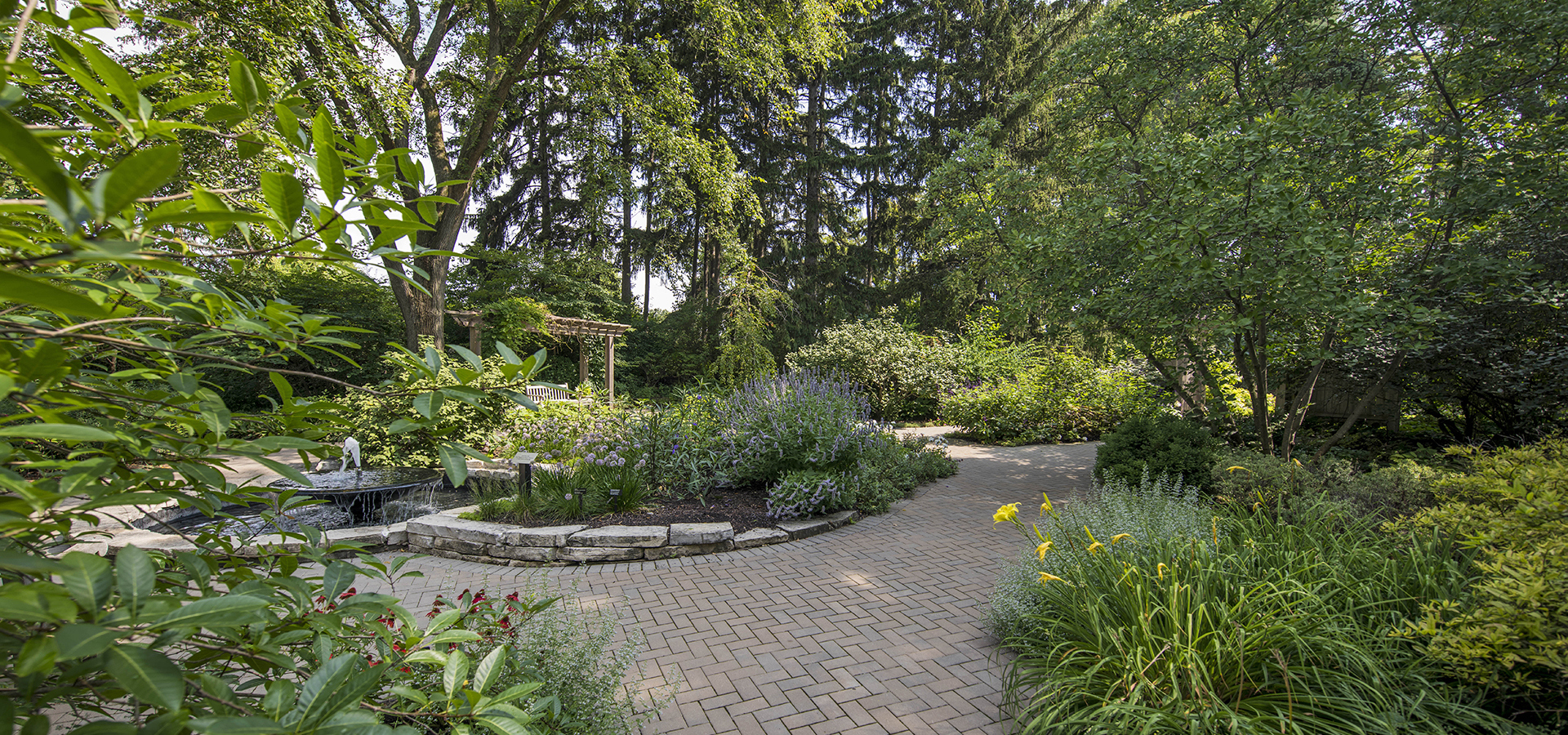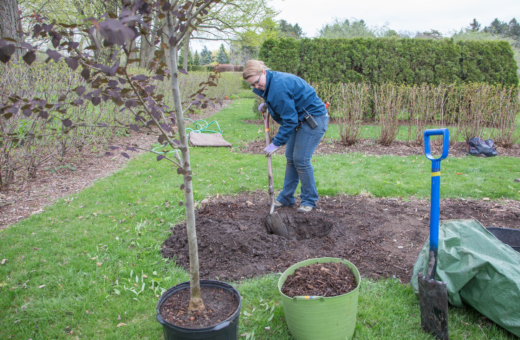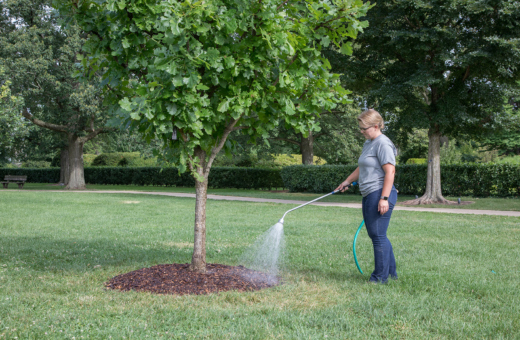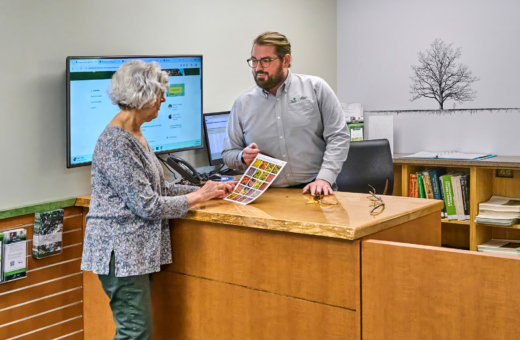Overview
All year round, but especially when spring is in bloom, the gardens of The Morton Arboretum invite guests to enjoy a beautiful and varied tapestry of flowers and foliage. Each of these spaces is a different experience, from sweeping splendor to shady seclusion. Gardeners seeking inspiration for their own landscapes can learn more about the plants they see in these gardens by visiting the Arboretum’s Plant Clinic.
Since different plants bloom at different times and the sights are always changing, it’s worth returning often during the spring bloom season.
Gardens near the Visitor Center
Arriving at the Arboretum brings you right into a garden. The parking lot for the Visitor Center (Parking Lot 1) is planted with a wide variety of attractive trees, flowering shrubs, and perennials for spring bloom and autumn color. As you approach the Visitor Center and pass through the breezeway into Arbor Court, you will pass seasonal gardens.
Several more gardens are within easy reach of the Visitor Center on the Arboretum’s East Side, mostly on paved paths (learn more about accessible paths and trails here).
Slider
Slider controls
Containers and display gardens: In addition to colorful flower beds, large containers are planted for seasonal beauty throughout the Arboretum’s gardens, in Arbor Court, and in the spaces around its main buildings . Since trees are central to the Arboretum, all these beds and containers include small trees or shrubs, underplanted with colorful flowers and fresh foliage. Plant Lists are available for gardeners who might want to try similar effects at home.
The Gerard T. Donnelly Grand Garden: This spectacular showplace, with fully accessible paths, is directly south of Arbor Court. It offers a variety of blooming experiences. The central Centennial Plaza is surrounded by colorful annuals and tall trellises with climbing vines. The Joy of Plants Garden at the west end is designed to showcase plants that would fit into home gardens. The Celebration Garden to the east has a color scheme based on shades of white and silver in flowers and foliage. At the far end, the Juniper Terrace is surrounded by cool green junipers and white-blooming hydrangeas.
Meadow Lake path: East of the Visitor Center,just steps from Arbor Court, Meadow Lake is surrounded by great sweeps of native plants, artfully massed and arranged. The half-mile paved trail that circles the lake is a delight in any season.
Ground Cover Garden: This shady garden is just south of Arbor Court, to the west of the main path. A wide variety of perennials and shrubs show how you can have a lovely garden in the shade of majestic trees.
Children’s Garden: It is designed as a place where children can freely play in nature, and as a garden that includes many attractive plantings. The entrance is in Arbor Court, across from the Visitor Center.
Maze Garden: A stroll through this puzzle made of living yews and other shrubs is a pleasant diversion, and a centuries-old tradition. In the center, around a great sycamore tree, is a raised viewing platform. There is a mini-maze for young children to enjoy next to the entrance, just across from the Children’s Garden.
Conifer Walk: Trees and shrubs, mostly evergreens, are clustered along with paved path. The collection includes the Garden Conifer Collection of dwarf evergreens.
Dwarf Woody Plants Collection: Shrubs and small trees suitable for home gardens, many of them spring- and summer-blooming, are showcased in this secluded garden east of the site of the new Firefly Pavilion. It is reached from the wood-chipped path that branches south from the Conifer Walk. A paved trail to the collection will be installed late in 2023.
May T. Watts Reading Garden: This tranquil hideaway honoring a pioneering nature educator is entered through the Sterling Morton Library. Stroll through the Ground Cover Garden to the Library entrance. The Reading Garden is notable for remarkable espaliers of ginkgo and dawn redwood trees around a small fountain.
Gardens on the West Side
If you follow the Main Route under Illinois Route 53 to the West Side of the Arboretum, you’ll find more gardens within an easy walk of the Thornhill Education Center (Parking Lot 21).
Slider
Slider controls
Joy Path: This was the favorite stroll of Arboretum founder Joy Morton when he lived in Thornhill, the Morton family’s country retreat on the site of what is now the education center. It leads south from the building, and along its upper reaches are several perennial gardens.
Fragrance Garden: Just west of the education center, at the start of the Joy Path, is a charming spot planted with trees, shrubs, and perennials that are notable for their scent. It’s a lovely place to sit and breathe.
Four Seasons Garden: A small parterre along the main path into the education center showcases plants that are interesting all year long.
Other Sights to Delight Gardeners in Spring
It takes a car, a bicycle, or a tram ride to appreciate all the best springtime sights of the Arboretum. You can park at any of 33 parking lots to take a short walk.
Slider
Slider controls
East Woods wildflowers: The restored oak woodlands offer a spectacular spring display. To enjoy their ever-changing beauty in April and May, take frequent walks along wood-chipped trails on the East Side between parking lots 10 and 13.
Magnolia Collection: The Arboretum’s nearly 100 magnolia trees bloom in many spots in early spring, but the greatest concentration is found on the East Side near Parking Lot 5. A group of large magnolias that are a favorite of guests and staff can be found along the Conifer Walk at the top of Frost Hill, near Parking Lot 3.
Ornamental Flowering Trees Collection: Crabapples, pears, and other spring-blooming trees are clustered along the Main Route on the West Side near Parking Lot 19.
Crabapple Collection: In late April or early May, dozens of kinds of flowering crabapple trees bloom in shades of white, pink, and red near Parking Lot 4 on the East Side.
Daffodil Glade: Great sweeps of daffodils bloom all over the Arboretum in spring, but the biggest display is to be found on the West Side near Parking Lot 22, between great old oaks.



